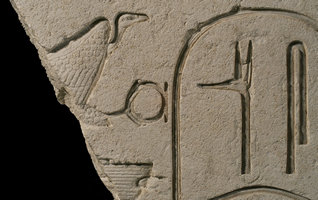
Kingship in Ancient Egypt
What is a king in Ancient Egypt?
There are several Ancient Egyptian words for king: nswt and ity are perhaps the most common. The Ancient Egyptian word for kingship is nsyt. In Ancient Egyptian lists of words ('onomastica'), kings are a separate category of beings. The character of kingship doubtless changed considerably over the three thousand years of Ancient Egyptian history, but there are some constant features:
UC 14335 the goddess Nekhbet as a vulture offers a Sn 'ring' to the name of king Senusret II (written in a cartouche)

The king is by nature divine - he is Horus, and offspring of Ra. However, he is also inhabiting a human body, and is therefore mortal. This duality of divine character and mortal constraints is the essence of Egyptian kingship.
The king is also distinguished by the crowns he wears, and by other items of dress, among which the most prominent include the following:
Depictions of the king often show a rearing cobra at the brow (in Egyptian iart 'the rising goddess', source of the term uraeus often used in Egyptology); the rearing cobra also protects the sun-god, and appears on the solar disk worn by goddesses. This is another feature reinforcing the solar character of Ancient Egyptian kingship.
|
'red crown'
|
'white crown'
|
king's head with a nemes headdress
|
king with 'blue crown'
|
The Divine Birth Cycle in Egyptian art
How literally should the title 'son of Ra' be interpreted? In the temple built for queen Hatshepsut as king at Deir el-Bahri, on the West Bank at Thebes (about 1450 BC), there is a cycle of figurative scenes narrating the divine birth of the king. The same sequence of scenes is found for the birth of king Amenhotep III in the temple of Amun at Luxor (about 1375 BC), and again in temples of the Ptolemaic and Roman Periods, where the birth of the god Horus is the subject. This Cycle of Divine Birth shows the creator-god Amun-Ra taking the form of a human man to impregnate the woman chosen to give birth to the future king: she is the human vessel within which the purely divine seed of the creator can grow. Thoth, god of knowledge and writing, appears to the woman to reveal that she is to give birth to the son of the creator.
In addition to these formal royal depictions, there is an earlier informal version in a literary narrative cycle preserved in one copy on a papyrus (Papyrus Westcar, now in the Egyptian Museum, Berlin). The copy dates to the Second Intermediate Period (about 1600 BC); the composition is in a late form of the Middle Egyptian phase of the language, indicating a date of composition in the late Middle Kingdom (about 2025-1700 BC) or Second Intermediate Period (1850-1600 BC). The tale relates the birth of three Fifth Dynasty kings to a woman named Ruddjedet, wife of a priest of Ra in Lower Egypt, during the reign of the Fourth Dynasty king Khufu; the birth is assisted by the goddesses Isis, Nephthys and Heqet, with the god Khnum as their porter.
What are the implications of this narrative?
Questioning the divinity of the king
Although there seems never to have been any expression of opposition to the belief in the divinity of the king, the mortality of the human body occupied by the king during his reign on earth provided opportunities for attitudes other than reverence. These find expression principally in literature: narrative tales may depict a king with qualities at variance with behavioural norms (Sneferu as lascivious, and Khufu as over-zealous in his quest for knowledge, both in the Tales from the Court of King Khufu, on Papyrus Westcar), and the Teaching of King Amenemhat I seems to describe the murder of the king.
In the limited data on political history, event by event, there are indications of strife at court, and attempted or successful plots against the reigning king:
Such events seem not to have disrupted the structure of kingship and belief in the divinity of the king: human beings have unlimited capacity for adaptation, and devout believers are able to destroy what seems, externally, central to the belief system.
Copyright © 2002 University College London. All rights reserved.